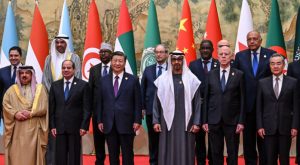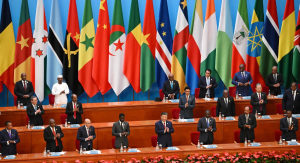PNN – The National Interest magazine examined Beijing’s strategy to expand its influence in the West Asian region, as the 11th China-Arab Countries Trade Conference was held and the tariff war intensified.
According to the report of Pakistan News Network, citing this American publication, China is institutionalizing partnerships with the Arabs through high-level forums and meetings, indicating Beijing’s long-term commitment to West Asia. In the 21st century, China has shifted the focus of its foreign policy toward building a global network of partnerships to expand its strategic influence. Unlike traditional Western alliances that rely on formal defense treaties, China’s diplomatic framework is characterized by a flexible, interest-based network of partnerships.
These partnerships enable China to maintain diplomatic coherence while expanding its global influence. They also facilitate cooperation amid inevitable geopolitical conflicts and allow it to engage with different countries while maintaining its strategic objectives. As Beijing continues to emerge as a global power, its engagement-based foreign policy will play an important role in shaping its interactions with the international community and its efforts to reform the global order.
The structure of China’s global partnerships
China’s diplomatic strategy uses a complex hierarchy of partnerships to categorize its international relations, reflecting varying levels of cooperation and strategic importance. Although this category has not been formally formulated, these partnerships can be broadly understood with descriptors such as “comprehensive,” “comprehensive,” “strategic,” and “futuristic,” which indicate different levels of collaboration. The unique diplomatic titles assigned to each country represent a tailored approach to international interactions that allows for maximum flexibility.
Beijing has structured its engagements in the Persian Gulf at three broad levels, reflecting the geopolitical and economic importance of each country. The first level includes a “comprehensive strategic partnership” with Iran, Saudi Arabia, Bahrain, and the UAE, highlighting their importance in China’s energy security and regional diplomacy. The second level includes “strategic partnerships” with Iraq, Kuwait, Oman, and Qatar, indicating strong but less comprehensive engagement.

The third level is the narrower “friendly cooperative relations,” which includes Yemen. This multi-layered approach reflects China’s pragmatic and interest-based diplomacy, allowing it to deepen economic and security ties while maintaining a delicate balance in a geopolitically unstable region.
The framework of “Community with a Shared Future” (CCD) and “New Era” are the main pillars of Chinese President Xi Jinping’s contemporary diplomatic strategy. These concepts reflect Beijing’s vision to reshape the global order in line with its strategic ambitions and counter American influence. The “community with a shared future” framework has become a key tool in China’s foreign policy, reflecting the country’s ambition to create an international environment that is consistent with its governance model and leadership ideals.
China’s Partnerships in Africa and West Asia
China’s expanding presence in Africa has profound geopolitical implications that directly challenge US strategic interests and alter the international order. As Beijing’s engagement intensifies, African countries are likely to recalibrate their approach and seek more balanced partnerships that align with their development aspirations and increase their bargaining power. Therefore, the trajectory of China-Africa relations will play a significant role in redefining global geopolitics and will have far-reaching implications for the evolving balance of power.
As with Africa, China’s approach to West Asia is a mix of economic pragmatism and strategic diversification. In contrast to the overarching multilateral frameworks seen in Africa, the approach in West Asia is largely characterized by bilateral engagements. These partnerships are rooted in economic cooperation, energy security, and infrastructure investments rather than multilateral diplomatic initiatives.

Despite China’s growing presence in West Asia, its influence is moderated by several factors, including regional complexities, geographical constraints, and the strategic role of West Asian countries. The continued dominance of the United States over regional security also constrains China’s broader geopolitical ambitions.
Nevertheless, China has steadily expanded its partnerships. Even Israel, a traditional American ally, has a distinct “Comprehensive Innovation Partnership” with China, reflecting its unique focus on technological and economic cooperation.
China has strategically used regional diplomatic platforms to strengthen its relations with Arab countries. The China-Arab States Cooperation Forum (CASCF), established in 2004, has played an important role in advancing China-Arab relations.

